| |
A song written in 1908 by Jack
Norworth and Albert Von Tilzer, "Take
Me out to the Ball Game" became the
official anthem of baseball. It is the
third-most frequently heard song in
America, behind the national anthem and
Happy Birthday. A look at 116 years of
memorabilia.
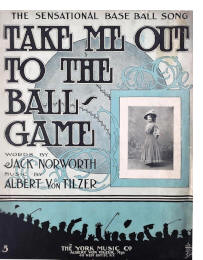 Norworth who had never been to a ball
game, wrote the lyrics when he passed
the Polo Grounds on an elevated train
and saw a sign that read “Baseball
Today.” The song was first sung by his
wife Nora Bayes and popularized by
various vaudeville acts. It was common
for Tin Pan Alley to print various
copies of the same sheet music
featuring different photos of
vaudeville singers.
Norworth who had never been to a ball
game, wrote the lyrics when he passed
the Polo Grounds on an elevated train
and saw a sign that read “Baseball
Today.” The song was first sung by his
wife Nora Bayes and popularized by
various vaudeville acts. It was common
for Tin Pan Alley to print various
copies of the same sheet music
featuring different photos of
vaudeville singers.
Those singers featured on the cover were actively promoting the song and
would receive compensation, especially
if the song became a hit. It is
reported that there were over 30
different covers to this sheet music.
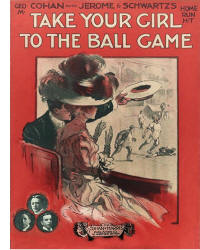 With the great success of 'Take
Me Out To The Ball Game,' came many copycat songs. Day's after Albert Von Tilzer and Jack Norworth’s
song was published, George
M. Cohan’s song “Take
Your Girl To The Ball Game” was released. The May 2,
1908, issue of Variety, points out the
similarities between the two baseball songs:
With the great success of 'Take
Me Out To The Ball Game,' came many copycat songs. Day's after Albert Von Tilzer and Jack Norworth’s
song was published, George
M. Cohan’s song “Take
Your Girl To The Ball Game” was released. The May 2,
1908, issue of Variety, points out the
similarities between the two baseball songs:
"SONG TITLES ALIKE. Two songs about the national summer game bearing
nearly precisely the same titles have
been the talk of the popular music
trade the past week. “Take Your Girl to
the Ball Game,” by Geo. M. Cohan, Wim.
Jerome and Jean Schwartz, published by
the Cohan & Harris Company, is one,
while "Take Me Out to the Ball Game" by
Jack Norworth and Albert Von Tilzer,
published by the New York Music
Company, is the other. Neither of the
publishing firms makes the usual claims
when a similarity in theme or title
arises. It is admitted that this
instance is simply peculiar."
Dedicated to the National game, "Take Your Girl to the Ball Game" by Geo.
Cohan, W.M. Jerome, and Jean Schwartz,
was billed as a novelty summer waltz
song and a home Run hit.
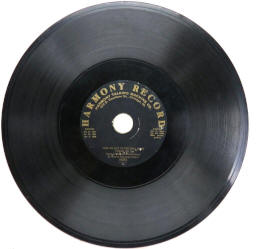 The very first version of "Take Me Out
To The Ball Game" was sung by Harvey
Hindermeyer recorded on a standard
record disc, with Columbia's "Client"
label, in August of 1908. The Standard
Disc Record had an oversized spindle
hole whic measured one-half inch. Much
larger then regular disc records.
The very first version of "Take Me Out
To The Ball Game" was sung by Harvey
Hindermeyer recorded on a standard
record disc, with Columbia's "Client"
label, in August of 1908. The Standard
Disc Record had an oversized spindle
hole whic measured one-half inch. Much
larger then regular disc records.
The Theory being that if you bought A Standard Disc Talking Machine with a
larger spindle, you would be locked
into buying only Standard Disc Records
with the larger spindle hole to fit the
machine. There were several other client disc. Companies that shared that
same concept and marketing ploy,
including Harmony. Harmony Records,
Talking Machine Company, 618 S.
Dearborn St., Chicago, Ill., released
"Take Me Out To The Ball Game" by
Harvey Hindermeyer, in 1911.
Harmony spindle hole was 3/4" in
diameter and they also sold Harmony
phonographs. The records could only be
played on its own large-spindled
phonographs.
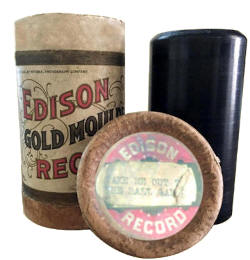 Months later, after Harvey Hindermeyer's
rendition of the famous baseball
classic, the second version of 'Take Me
Out To The Ball Game was released. On
September 8, 1908, the song was
recorded on an
Edison "Gold Moulded" Cylinder Record.
This recording was performed by Edward
Meeker.
Months later, after Harvey Hindermeyer's
rendition of the famous baseball
classic, the second version of 'Take Me
Out To The Ball Game was released. On
September 8, 1908, the song was
recorded on an
Edison "Gold Moulded" Cylinder Record.
This recording was performed by Edward
Meeker.
By the end of the 19th century, as the limitations of brown wax cylinders
became increasingly evident, Edison
returned to the laboratory in an
attempt to make refinements to his
pioneering developments in sound
recording. The "Gold-Moulded" process,
developed in 1902, significantly
improved these limitations.
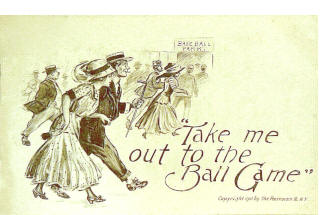 Copyrighted in 1910 by the Fairman Co. of
NY, this
'Take Me Out To The Ball Game'
postcard illustrates a man and a woman
rushing to the game. All dressed in
early 1900s garb, other fans are
entering the "Base Ball Park" gate.
Copyrighted in 1910 by the Fairman Co. of
NY, this
'Take Me Out To The Ball Game'
postcard illustrates a man and a woman
rushing to the game. All dressed in
early 1900s garb, other fans are
entering the "Base Ball Park" gate.
The drawing is typical to the style used on other items of the period. The
back of the post card has a (DB)
Divided Back...
A postcard back with a center line to divide the address from the message.
Divided backs first appear in the U.S.
in 1907. This helps to date unused
postcards. Cards before this date, have
undivided backs.
Postcard size can also help date a postcard with the absence of a
postmark. If the card is old and larger
than 3.5 by 5.5 inches, it may date
from before 1898. Slightly smaller than
3.5 by 5.5 inches, it may date from
1898-1902. If the card measures 3.5 by
5.5 inches, it was probably made
between 1902-1970.
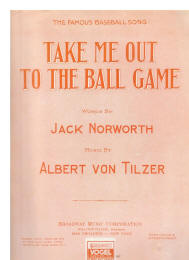 In 1927, Jack Norworth wrote, and
copyrighted, alternative lyrics,
replacing "Katie Casey" with a new
heroine called "Nelly Kelly." The
different versions of verse do have
some similarities but also significant
differences, however the chorus
remained the same in both versions.
In 1927, Jack Norworth wrote, and
copyrighted, alternative lyrics,
replacing "Katie Casey" with a new
heroine called "Nelly Kelly." The
different versions of verse do have
some similarities but also significant
differences, however the chorus
remained the same in both versions.
The copyright was renewed in 1936 by Albert Von Tilzer, and assigned to
Broadway Music Corp. Albert's brother
Will was president of the company. Jack Norworth also
renewed the copyright, and it was
assigned to Jerry Vogel Music Co., Inc.
Both Companies are credited on the
1936 "Take Me Out To The Ball Game"
Sheet music.
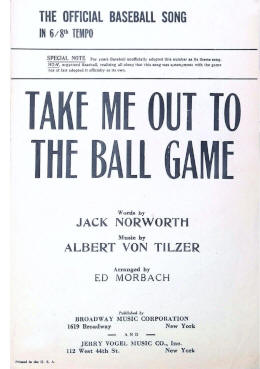 This sheet music was
also Copyrighted in 1936 by publishers Albert
von Tilzer; Broadway Music Corporation;
and Jack Norworth; Jerry Vogel Music
Co. Inc.
The music was Arranged by Ed Morbach for an orchestra performance,
which is still used today by schools
and the military. Instrument
arrangements in the sheet include;
Piano, violin, cello, banjo, Trumpet,
and clarinet. This sheet music was
also Copyrighted in 1936 by publishers Albert
von Tilzer; Broadway Music Corporation;
and Jack Norworth; Jerry Vogel Music
Co. Inc.
The music was Arranged by Ed Morbach for an orchestra performance,
which is still used today by schools
and the military. Instrument
arrangements in the sheet include;
Piano, violin, cello, banjo, Trumpet,
and clarinet.
The top of the sheet
cover reads: "THE OFFICIAL BASEBALL
SONG In 6/8th Tempo" below reads:
"SPECIAL NOTE For years Baseball
unofficially adopted this as it's theme
song. NOW, organized baseball,
realizing all along that this song was
synonymous with the game has at last
adopted it officially as it's own."
It
was reported in 1935; that John Heydler,
National League President, and William
Harridge, of The American League, got
together a couple of years earlier and
adopted the song as the game official
anthem. Most of the information is
speculative, as to the motive leading
to the decision. Inspired by love of
musical expression, or in hope of
having a certain box-office
appeal.
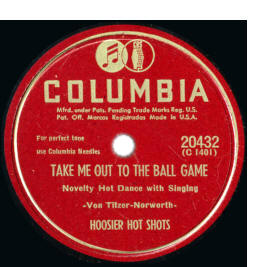 The song had been recorded countless
times since it was written in 1908. The
first verse of the 1927 version was
recorded by Dan Hornsby for Columbia
Records in 1929. The
Hoosier Hot Shots
recorded the song on the Melotone
Record label in 1936.
The song had been recorded countless
times since it was written in 1908. The
first verse of the 1927 version was
recorded by Dan Hornsby for Columbia
Records in 1929. The
Hoosier Hot Shots
recorded the song on the Melotone
Record label in 1936.
Columbia Records reissued the song in 1940. During the 1930s and 1940s,
the Hoosier Hot Shots developed a style
of musical comedy described as rural
Jazz. The quartet featured; Gil Taylor
(string bass); Ken "Rudy" Trietsch
(vocal, guitar); Charles Otto "Gabe"
Ward (vocal, clarinet); Paul "Hezzie"
Trietsch (vocal, washboard, whistle)
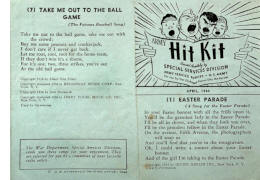 During WWII, from 1943-1945, the
Special Services Division Army service
Forces, issued "Hit Kits" to U.S.
Solders both home and abroad. Issued
monthly, the "Army Hit Kits Of Popular
Songs," featured words and music of
songs selected by a committee of
prominent musicians.
During WWII, from 1943-1945, the
Special Services Division Army service
Forces, issued "Hit Kits" to U.S.
Solders both home and abroad. Issued
monthly, the "Army Hit Kits Of Popular
Songs," featured words and music of
songs selected by a committee of
prominent musicians.
"For Use By The U.S. Armed Forces Only. Not For Sale" the Hit Kits came in
two formats.
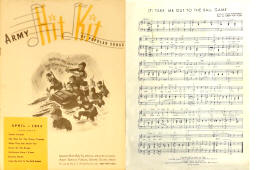 Pocket size, 3.50" x 5.25" folders,
with song lyrics were distributed among
groups, belonging to the same unit. The
music for piano and voice were prepared
in a standard sheet music size 8" by
11" folders. The contents of the
April 1944, 12 page standard sheet
music size, Army Hit Kit included
the song 'Take Me Out To The Ball
Game,' and the pocket size was printed
with the lyrics, only.
Pocket size, 3.50" x 5.25" folders,
with song lyrics were distributed among
groups, belonging to the same unit. The
music for piano and voice were prepared
in a standard sheet music size 8" by
11" folders. The contents of the
April 1944, 12 page standard sheet
music size, Army Hit Kit included
the song 'Take Me Out To The Ball
Game,' and the pocket size was printed
with the lyrics, only.
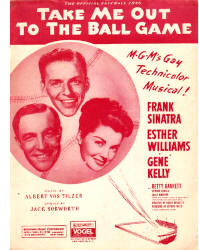 Sheet music from the 1949 MGM
Technicolor musical film, "Take Me Out
to the Ball Game." The movie stars;
Frank Sinatra, Esther Williams, and
Gene Kelly, features Betty Garrett,
Edward Arnold and Jules Munshin. The
title and nominal theme is taken from
Jack Norworth's Take Me Out to the Ball
Game.
Sheet music from the 1949 MGM
Technicolor musical film, "Take Me Out
to the Ball Game." The movie stars;
Frank Sinatra, Esther Williams, and
Gene Kelly, features Betty Garrett,
Edward Arnold and Jules Munshin. The
title and nominal theme is taken from
Jack Norworth's Take Me Out to the Ball
Game.
The Musical's openenig song features Frank Sinatra and Gene Kelly
performing a shortened 1927 revisited
"Katie Casey" version of the song, on a
Vaudeville stage.
The sheet music for "Take Me Out to the Ball Game" was published by the
Jerry Vogel Co. Inc., reprinted by
permission of the Broadway Music
Corporation, Will Von-Tilzer President.
The red-tone, and white cover features
head shots of Gene Kelly, Esther
Williams, and Frank Sinatra.
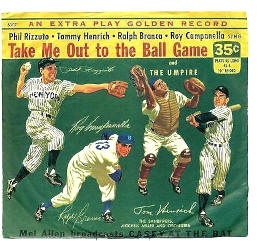 Distributed by Simon & Shuster in 1952,
Little Golden Records issued this 7
inch Extra-Play Golden Record, which
plays as long as a ten-inch record.
Distributed by Simon & Shuster in 1952,
Little Golden Records issued this 7
inch Extra-Play Golden Record, which
plays as long as a ten-inch record.
Side one features two songs; "Take Me Out to The Ball Game" and Song two,
"The Umpire." Both feature the singing
voices of New York Yankees Phil Rizzuto,
Tommy Henrich, Brooklyn Dodgers Ralph
Branca, Roy Campanella, with Anne
Lloyd, The Sandpipers, Mitchell Miller
And Orchestra.
Side two features "Casey at the Bat" performed by "famous sports
announcer" Mel Allen. The front of the
paper dust jacket features action
illustrations of the four ballplayers
accompanied by their facsimile
autographs on a green background. A 10
inch version of the record was also
made with a yellow record, that does
not have the Mel Allen Broadcast of
"Casey at the Bat." Side 1 "Take Me out
to the Ball Game" Side 2 "The Umpire.
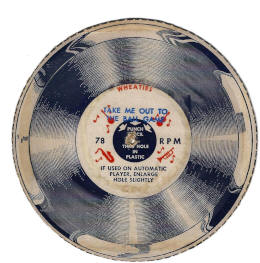 In 1953 Rainbo
Records developed a thin
micro-plastic record,
manufactured in a
continuous web, resulting
in numerous patents,
domestically and
internationally. This
Wheaties record,
"Take Me
Out To The Ball Game"
was part of a 9 record set,
produced for a 1954
promotion. In 1953 Rainbo
Records developed a thin
micro-plastic record,
manufactured in a
continuous web, resulting
in numerous patents,
domestically and
internationally. This
Wheaties record,
"Take Me
Out To The Ball Game"
was part of a 9 record set,
produced for a 1954
promotion.
The "Record on a box" was born. In 1955 Rainbo Records introduced a
patented method to produce the
flexible records as the
"Record-On-A-Box" for a Wheaties
promotion. Using Rainbo built and
refined equipment, the company
produced over 30 million records
for Wheaties over the next several
years.
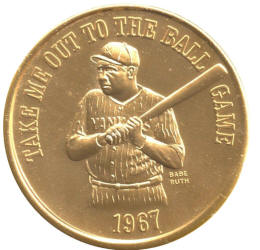 Mardi Gras Doubloons also known as
"throws," commemorate various Mardi
Gras Krewes (parade or carnival
celebration). They are typically made
of aluminum and are thrown from floats
in carnival parades.
Mardi Gras Doubloons also known as
"throws," commemorate various Mardi
Gras Krewes (parade or carnival
celebration). They are typically made
of aluminum and are thrown from floats
in carnival parades.
Other heavier metals such as bronze or silver are sometimes used to mint
coins for collectors, souvenirs, or
made to be gifted as favors. The first
doubloons depicting a Major League
ballplayer featured Babe Ruth in 1967.
A hundred Thousand gold-colored;
"Take Me Out to the Ball Game" themed
doubloons were created by
advertising salesman Ed Muniz for the
new Krewe of Endymion.
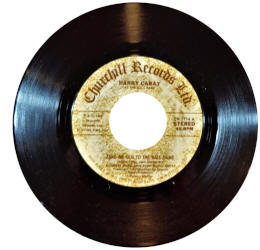 In 1978, Churchill Records released a
45 RPM record entitled Harry Caray At
The Ballpark. Side A features
"Take Me Out To The Ball Game."
Caray performed the song traditionally
with the crowd, in the middle of the
seventh inning, of a baseball game.
This version of the song, recorded
by Harry Caray in the studio, was done
with a disco beat.
In 1978, Churchill Records released a
45 RPM record entitled Harry Caray At
The Ballpark. Side A features
"Take Me Out To The Ball Game."
Caray performed the song traditionally
with the crowd, in the middle of the
seventh inning, of a baseball game.
This version of the song, recorded
by Harry Caray in the studio, was done
with a disco beat.
Executive producer Tommy Martian said, Harry Caray sang the song in Ft.
Wayne, Ind., accompanied by local
studio musicians there. The background
voices and instruments portion was
recorded in Nashville Tenn. The Crowd
nose on the record is an actual White
Sox crowd cheering on opening day
rather than moaning later n in the
season.
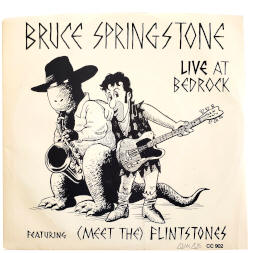 "Bruce Springstone," a Springsteen
parody group, was created by Baltimore
musicians-songwriters Tom Chalkley and
Craig Hankin. The single "Bruce
Springstone: Live at Bedrock" 45
RPM record features "Bedrock Rap/Meet
the Flintstones," on side-A. The
flip-side, is a Springsteenesque
arrangement of "Take Me Out to the
Ballgame,"
"Bruce Springstone," a Springsteen
parody group, was created by Baltimore
musicians-songwriters Tom Chalkley and
Craig Hankin. The single "Bruce
Springstone: Live at Bedrock" 45
RPM record features "Bedrock Rap/Meet
the Flintstones," on side-A. The
flip-side, is a Springsteenesque
arrangement of "Take Me Out to the
Ballgame,"
The cover depicts Bruce Springstone as a cross between Springsteen and
Fred Flintstone; leaning against a
mixture of E-Street Band saxophonist
Clarence Clemons and Dino the Dinosaur.
The back of the sleeve depicts Bruce Springstone in his pinstripe Bedrock
baseball uniform sliding into home with
guitar in hand. The cover design was
done by John Ebersberger (drums) and
Tom Chalkley, who does the impeccable
Springsteen impersonation. Craig Hankin,
plays the Springsteenian Guitar.
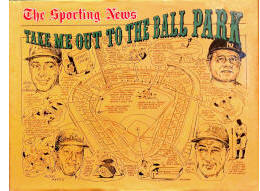 In 1984 The Sporting News published a
Coffee Table Book titled "Take Me Out To
The Ball
In 1984 The Sporting News published a
Coffee Table Book titled "Take Me Out To
The Ball Game Park" OK... OK... I know,
but because of the clever play on words, it will make this months
Newsletter.
"Take
Me Out To The Ball Park" by Lowell
Reidenbaugh features profiles of the
great major league ballparks, with
illustrated drawings and photographs.
Ballpark drawings were done by sports
cartoonists Amadee Wohlschlaeger, and
Gene Mack. Amadee, as he signs his
work, was a St. Louis Post Dispatch
cartoonist. The book captures the
romance of a major league ballpark. No
two are alike, and each has a character
of it's own.
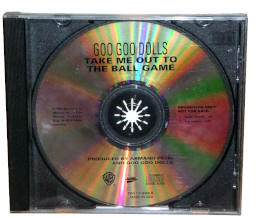 In 1996 Major League Baseball had the
problem of filling stadium seats since
the player strike of '94, and sport's
demographics people particularly
recognized there were fewer kids in the
stands than ever.
In 1996 Major League Baseball had the
problem of filling stadium seats since
the player strike of '94, and sport's
demographics people particularly
recognized there were fewer kids in the
stands than ever.
In addition, baseball found that fewer and fewer kids have continued
playing the game over a certain age
group. So baseball focused on getting
the attention of kids from 6 to 17.
It used the FOX network to air commercials based on the song "Take Me Out
To The Ball Game." One commercial
featured LL Cool J. The other had been shot
with Atlanta Brave players; Tyler
Houston, Ryan Lesco, Javeir Lopez, and
the rock band Goo Goo Dolls.
The Promotional CD features; Track 1 -
Take Me Out To The Ball Game (Radio
Version) 0:58; and Track 2 - Take Me
Out To The Ball Game (Full Version)
1:00
Metropolitan
Transportation Authority BusTalk
Advertising ''Take Me Out to the Ballgame! From June 14 through September 22, 2001 the
New York Transit Museum featured an
Exhibition of the history of baseballs
subway series, on view at the museum's
Grand Central Terminal annex.
|
|
| |
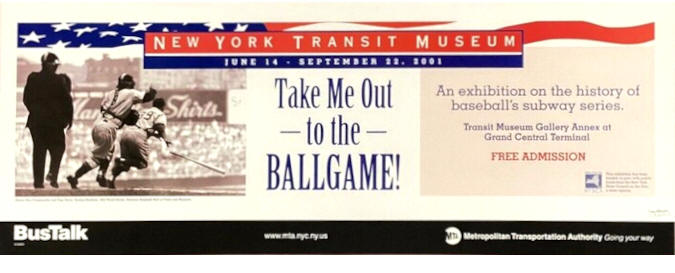 |
|
| |
With help from the National Baseball Hall of Fame in Cooperstown, the
Transit Museum had put together a
display of memorabilia and photographs
recalling the legendary intercity
rivalries that pitted the Yankees, New
York Giants and Brooklyn Dodgers
against one another before the Giants
and Dodgers left for California in
1957.
The exhibition included such iconic items as spikes worn by Babe Ruth and
Casey Stengel, a bat used by Lou
Gehrig, a glove owned by Joe DiMaggio,
a photo of Willie Mays playing stick
ball in Harlem, World Series programs, Ebbets Field seats and
the defunct ballparks home plate. A cover of Sheet
music of "Take Me Out To The Ball Game"
was also displayed at the exhibit. The
lyrics were written on the Ninth Avenue
El.
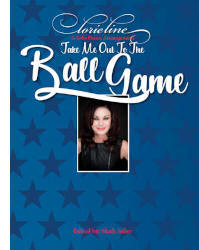 In 2018 Hal Leonard Corp. published the
sheet music for
Lorie Line's "Take Me
Out to the Ball Game" piano arrangement which she performed at Kirby Puckett's
memorial service March 6, 2006. It was
the last song to be played at the
service and Lorie hoped it would be
appropriate and honor the Twin Cities
legend.
In 2018 Hal Leonard Corp. published the
sheet music for
Lorie Line's "Take Me
Out to the Ball Game" piano arrangement which she performed at Kirby Puckett's
memorial service March 6, 2006. It was
the last song to be played at the
service and Lorie hoped it would be
appropriate and honor the Twin Cities
legend.
Following the service, a big guy stood
in line to meet Lorie. It was a
memorable day as the big guy said,
"Hey, I'm Kent Hrbek and I'd like for
you to play that song for me when I
die!"
In 2019 Hal Leonard also published the
sheet music for Lorie Line's piano
arrangement of the fight song for the
Minnesota Twins "We're Gonna Win,
TWINS!" The song played when the team
takes the field before every home game
since the team moved to Minnesota in
1961. Lorie Line was inducted into the
Minnesota Music Hall of Fame in 2015.
She joins the ranks with Bob Dylan,
Prince and Judy Garland.
On July 16, 2008, in Washington, DC,
the Postal Service issue the
42˘ "Take Me Out to the Ball Game"
stamp to commemorate the 100th
anniversary of the song. The stamp
designed by Richard Sheaff, depicts a
gloveless 19th century ballplayer
holding a ball, with a game being
played in the background. The 42 face
value (cents) appears in a baseball at
the top. |
|
| |
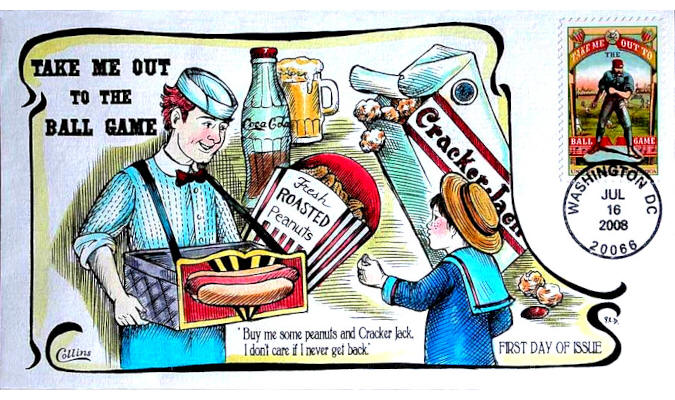 |
|
| |
The First
day cover pictured above features the
artwork of Fred Collins. It depicts a
ballpark Hotdog vendor, a Coke, a
beer..."Buy me some peanuts and Cracker
Jack, I don't care if I ever get back"
which is also deicted. Making First Day
Covers his life's work, Collins hand
painted FDCs have been produced since
1978. An involved member of the
philatelic community, his reputation
for superb quality has continued to
grow. |
|
| |
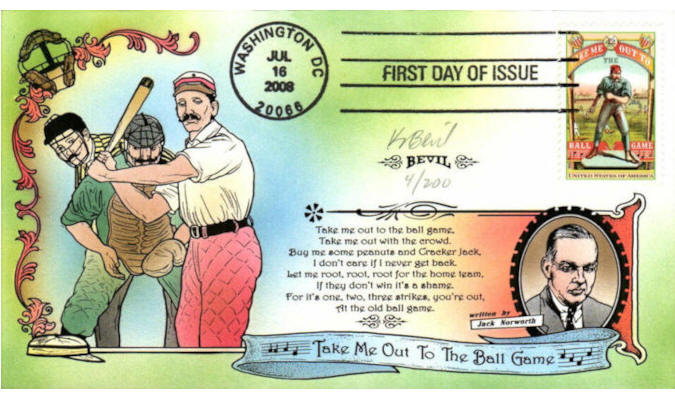
|
|
| |
The First Day Cover pictured
above is hand painted, signed and
numbered by sports cachet artist Kendal
Bevil, 4/200. It depicts an early 1900s
umpire, catcher, and batter wearing
quilted padding baseball pants. To the
right of a verse of "Take Me Out to The
Ball Game" is an illustration of writer
Jack Norworth. Artist Kendal Bevil, is
one of the most popular cachet makers,
producing first-day covers since 1989.
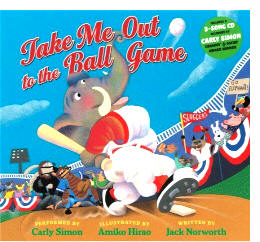 "Take Me Out To The Ball Game," is
featured in this children's book
illustrated by Amiko Hirio. The book
came with a CD with three songs
performed by Grammy and Oscar award
winner Carly Simon. The songs; "I Gave
My Love a Cherry," - "Scarborough
Fair," and
"Take Me Out to the Ball Game," which
can be sung along with the 21 pages of
lyrics in the picture book.
"Take Me Out To The Ball Game," is
featured in this children's book
illustrated by Amiko Hirio. The book
came with a CD with three songs
performed by Grammy and Oscar award
winner Carly Simon. The songs; "I Gave
My Love a Cherry," - "Scarborough
Fair," and
"Take Me Out to the Ball Game," which
can be sung along with the 21 pages of
lyrics in the picture book.
Carly Simon's version of "Take Me Out To The Ball Game" was originally
recorded for Ken Burns' documentary
"Baseball." Simon's connection to
baseball goes back to her childhood.
Her father, Simon & Schuster co-founder
Richard Simon, helped Jackie Robinson
buy a house in
Stamford, Conn., in the mid-1950s, at a
time when the community resisted
letting blacks live there. Carly's
family was friendly with Jackie
Robinson's family when she was a girl
and the Brooklyn Dodgers star used to
bring her to games and call her his
"lucky charm."
The Colorful, collage-like illustrated book introduces young fans to
baseball. Katie Casey, the
baseball-loving cat, is Root, Root,
Rooting for the Home team at Slugger
Stadium where two teams consisting of
an array of animal ballplayers,
alligators, giraffes, elephants, hippos
and other wildlife are competing.
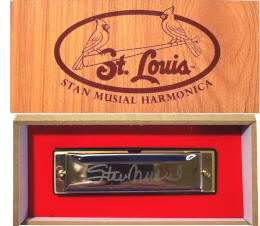 On Friday, April 12, 2013, "Stan Musial
Night"
every fan 16 and over received a harmonica as
they entered the gate. During the
seventh-inning stretch, In tribute,
they joined together to play "Take Me
out To The Ball Game. The harmonicas
have an imprint of Musial's signature,
came in a wooden decorative box, and
How to play harmonica, "Take Me Out To
The Ball Game" sheets. The harmonica is
numbered, so it could be played by
following the numbers on the sheet.
Inside the box reads:
On Friday, April 12, 2013, "Stan Musial
Night"
every fan 16 and over received a harmonica as
they entered the gate. During the
seventh-inning stretch, In tribute,
they joined together to play "Take Me
out To The Ball Game. The harmonicas
have an imprint of Musial's signature,
came in a wooden decorative box, and
How to play harmonica, "Take Me Out To
The Ball Game" sheets. The harmonica is
numbered, so it could be played by
following the numbers on the sheet.
Inside the box reads:
"Often praised as "baseball's perfect warrior' for the way he played the
game, Stan Musial ws well known for
playing the harmonica. "The Man's"
rendition of "Take Me Out To The Ball
Game" was frequently a prelude at
public gatherings, such as Cardinal
games, the Baseball Hall Of Fame
induction ceremony, and other charity
events. Stan's talents were even on
display in the nation's capital, when
he entertained the White House prior to
receiving the Presidential Medal of
Freedom in 2011." |
|
| |
|
|
| |
|
|
| |
KEYMAN COLLECTIBLES
RELATED RESOURCES |
|
| |
|
|
| |
|
|
| |
Half the fun of
collecting is showing off your collection to
others. Lets See your Room! |
|
| |
|
|
| |
Showcase
your collection on KeyMan Collectibles for Free!.
Just send pictures, and
Get Your Collectors Showcase Room Now! |
|
| |
|
|
| |
KeyMan
Collectibles Collectors Corner
- Keep up with the latest collecting news,
announcements, and articles of interest on the
webs best resource for baseball memorabilia. |
|
| |
KeyMan Collectibles Baseball
Memorabilia Facebook Group -
Post Questions and comments relating to
Baseball Collectibles and Memorabilia. Interact
with other collectors or show off your
collection. |
|
| |
KeyMan
Collectibles Forum
- A great option for those that "Don't do
facebook" Post Questions and
comments relating to Baseball Collectibles and
Memorabilia |
|
|


